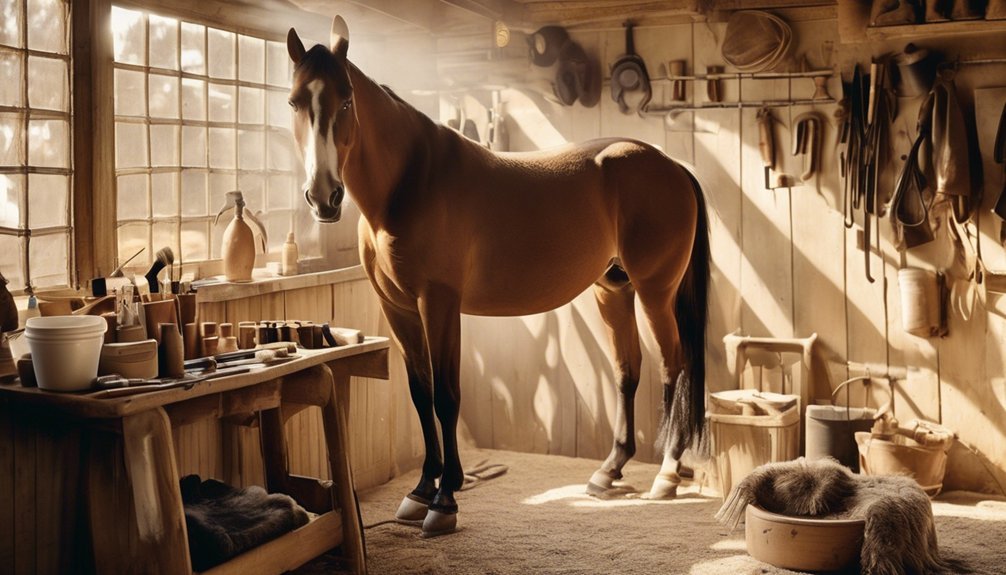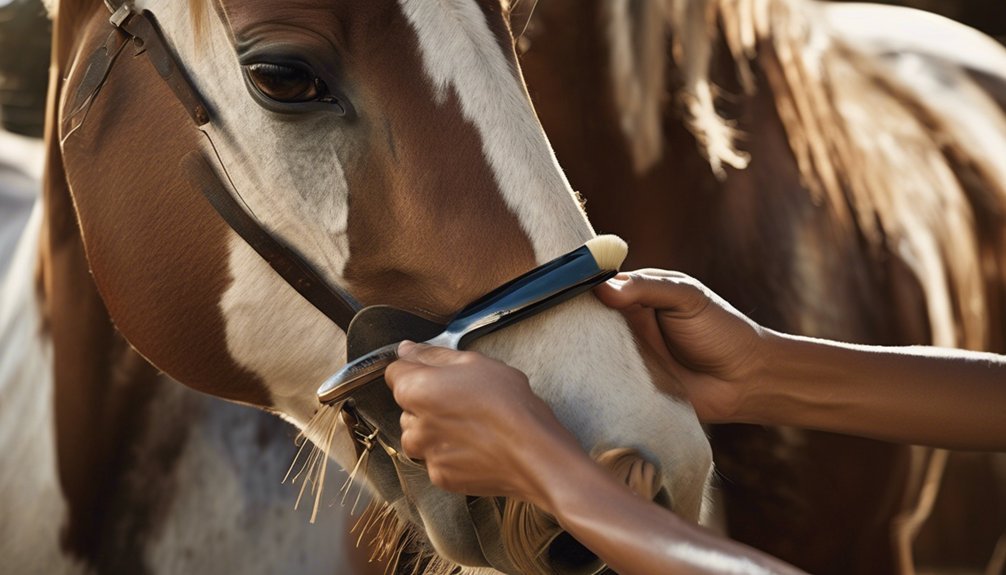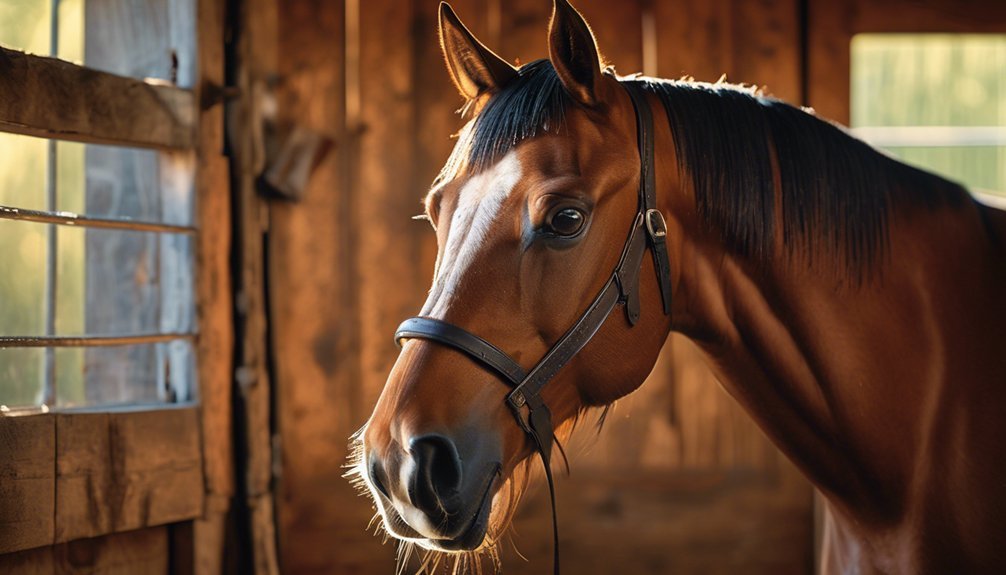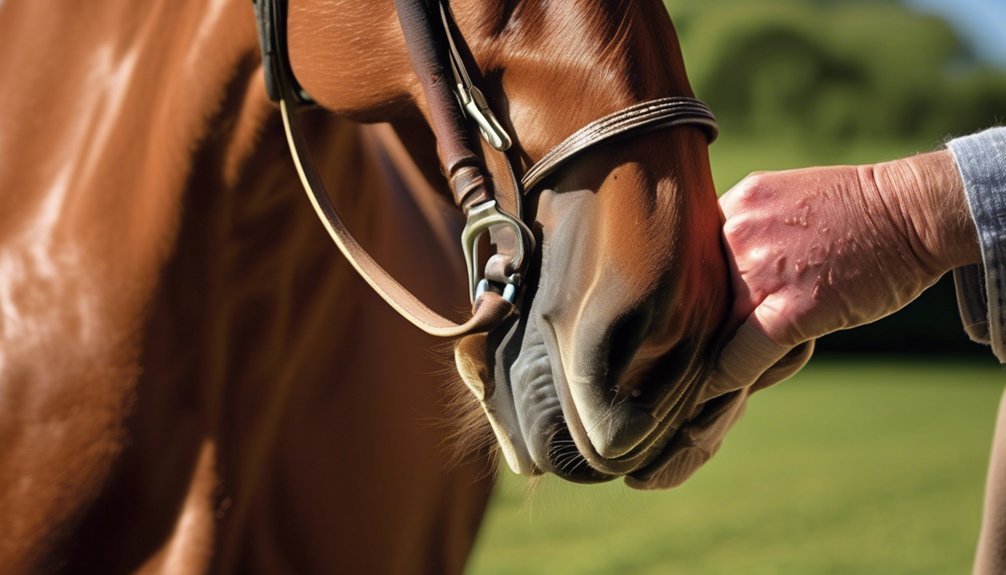
When it comes to grooming horses with sparse coats, understanding the unique needs of their skin and hair is essential. You'll want to approach grooming with care, using the right tools to avoid irritation while promoting coat health. Noticing changes in texture during grooming can be a crucial indicator of underlying issues. So, what specific techniques can enhance their grooming routine and overall coat quality? Let's explore the best strategies together.
Key Takeaways
- Assess the horse's coat regularly for changes in texture, indicating potential health or nutritional issues that may require attention.
- Use a soft-bristled brush to gently remove dust without irritating sensitive skin, promoting comfort and cleanliness.
- Incorporate essential fatty acids and vitamins in the horse's diet to enhance coat health and promote growth.
- Maintain a consistent grooming schedule to strengthen the bond with your horse while supporting skin health and overall well-being.
- Employ a rubber curry comb in circular motions to effectively loosen dirt, followed by a stiff-bristled brush for thorough cleaning.
Understanding Sparse Coats: Causes and Solutions

When you notice your horse's coat looking sparse, it can be disheartening, especially since a shiny, full coat often reflects good health.
Sparse coats can stem from coat genetics; some breeds naturally have thinner fur. However, environmental factors play a significant role too. Changes in temperature, humidity, or exposure to sunlight can affect your horse's coat condition.
Poor nutrition is another culprit, so ensure your horse gets a balanced diet rich in vitamins and minerals.
Stress and illness can also contribute to coat issues, so keep an eye on your horse's overall well-being.
Essential Grooming Tools for Sparse-Coated Horses
Grooming a sparse-coated horse requires the right tools to promote a healthy, vibrant appearance. Start with a soft-bristled brush, perfect for sensitive skin, as it gently removes dust without causing irritation.
A rubber curry comb is essential for loosening dirt and stimulating the skin, encouraging blood flow and coat health. For finer detailing, consider a mane and tail comb to prevent breakage while keeping those areas tangle-free.
Regular grooming frequency is key; aim for several times a week to maintain the coat's luster and overall well-being. Each stroke not only nurtures your horse's coat but also strengthens your bond, allowing you to connect deeply while caring for your cherished companion.
Establishing a Regular Grooming Routine

Building on the importance of using the right tools, establishing a regular grooming routine is vital for maintaining your horse's health and appearance. Aim for a consistent grooming frequency, ideally every few days, to promote skin health and strengthen your bond.
During each session, take time for a thorough coat assessment; this not only helps you spot any issues early but also allows you to appreciate the unique qualities of your horse's sparse coat. Pay attention to changes in texture or condition, as these can signal nutritional or health needs.
Techniques for Effective Grooming
Mastering effective grooming techniques can transform your horse's care routine into a rewarding experience for both of you.
Start with a soft curry comb, using gentle circular motions to loosen dirt and debris from their sparse coat. Follow up with a stiff-bristled brush to remove the loosened particles, always brushing in the direction of hair growth. Pay special attention to areas prone to irritation, ensuring you promote healthy coat maintenance.
Use a fine-toothed comb for the mane and tail, detangling slowly to avoid discomfort. Finally, finish with a soft cloth to add shine, fostering that beautiful bond between you and your horse.
With these techniques, you'll not only enhance your horse's appearance but also nurture their well-being.
The Importance of Skin Health

While you might focus on your horse's shiny coat and well-kept mane, skin health is equally vital for their overall well-being. Healthy skin ensures proper skin hydration, which prevents dryness and irritation. When your horse's skin is hydrated, it supports a vibrant coat and reduces the risk of skin infections.
By regularly grooming, you stimulate blood flow, which nourishes the skin and promotes healing. Additionally, using appropriate grooming products can provide essential coat protection, shielding against environmental stressors like sun and insects.
Nutrition and Its Impact on Coat Quality
Nutrition plays a crucial role in determining the quality of your horse's coat, as the right balance of nutrients can make a noticeable difference in its shine and health.
To enhance your horse's coat, consider making dietary adjustments that address any potential nutrient deficiencies. Essential fatty acids, like Omega-3 and Omega-6, promote a soft, lustrous coat, while vitamins A, E, and biotin support skin health and growth.
Including high-quality forage and grains rich in these nutrients can transform your horse's appearance. Don't forget about minerals like zinc and copper, which play vital roles in coat pigmentation and structure.
Managing Seasonal Changes in Coat Thickness

How do you keep your horse comfortable as the seasons change and its coat thickens or thins? Managing seasonal changes is essential, especially during periods of seasonal shedding and temperature fluctuations.
Here are three key tips to help you:
- Adjust Grooming Routine: During shedding, increase grooming sessions to remove loose hair and promote airflow to the skin.
- Monitor Blanketing: Use appropriate blankets based on temperature shifts. A lighter blanket in warmer months prevents overheating, while a thicker one keeps them cozy in colder weather.
- Provide a Comfortable Environment: Ensure your horse's shelter is well-ventilated but shielded from harsh winds, allowing their coat to adapt naturally to the changing seasons.
Supplements to Promote Healthy Coat Growth
To ensure your horse's coat remains vibrant and healthy, incorporating the right supplements can make a significant difference. Essential nutrients like Omega-3 fatty acids, biotin, and zinc are vital for promoting coat growth and enhancing shine.
Here's a quick reference table to help you choose the right coat supplements:
| Nutrient | Benefits | Sources |
|---|---|---|
| Omega-3 Fatty Acids | Reduces inflammation, improves shine | Flaxseed oil, fish oil |
| Biotin | Supports hair strength and growth | Alfalfa, oats |
| Zinc | Aids in cellular function and coat health | Meat, legumes |
When to Consult a Veterinarian for Coat Issues

Even with the best supplements in your horse's diet, coat issues can still arise, signaling a need for professional insight.
Recognizing when to seek a veterinary assessment is crucial for your horse's well-being.
Here are three signs that warrant a coat diagnosis:
- Persistent Hair Loss: If your horse's coat is thinning despite proper care, it's time to consult a vet.
- Skin Irritation: Redness, itching, or flakiness may indicate an underlying condition needing professional evaluation.
- Changes in Coat Texture: A sudden shift in texture, such as brittleness or excessive oiliness, can reveal health issues that require attention.
Frequently Asked Questions
Can I Use Human Shampoo on My Horse's Sparse Coat?
You can use human shampoo on your horse's sparse coat, but be cautious. Always check for harsh chemicals, and prioritize equine coat care products to maintain your horse's skin health and coat vitality.
How Often Should I Wash a Horse With a Sparse Coat?
You should wash your horse with a sparse coat every two to four weeks, focusing on coat health maintenance. Regular sparse coat grooming helps improve skin condition, encourages growth, and strengthens the bond between you and your horse.
Are Specific Breeds More Prone to Sparse Coats?
Yes, specific breeds like Arabian horses often exhibit finer, sparser coats. Thoroughbred coats can also be thinner, especially in certain individuals. Understanding these traits helps you provide the best care for your horse's unique needs.
Can Weather Affect My Horse's Sparse Coat Condition?
Imagine a garden affected by storms; your horse's sparse coat mirrors that struggle. Weather influences seasonal coat changes, so focus on nutrition. A balanced diet nourishes resilience, helping your horse thrive despite nature's whims.
What Are the Best Natural Remedies for Sparse Coats?
To enhance your horse's coat, consider incorporating oat nutrition and coat supplements into their diet. These natural remedies nourish from within, promoting a healthier, shinier coat that reflects your love and care for them.
Conclusion
In conclusion, grooming horses with sparse coats requires dedication and the right techniques. Did you know that nearly 30% of horses may experience coat issues due to poor nutrition or skin conditions? By understanding your horse's unique needs and maintaining a consistent grooming routine, you can significantly improve their coat health. Remember, a beautiful coat not only enhances your horse's appearance but also contributes to their overall well-being, making your grooming efforts truly worthwhile.





